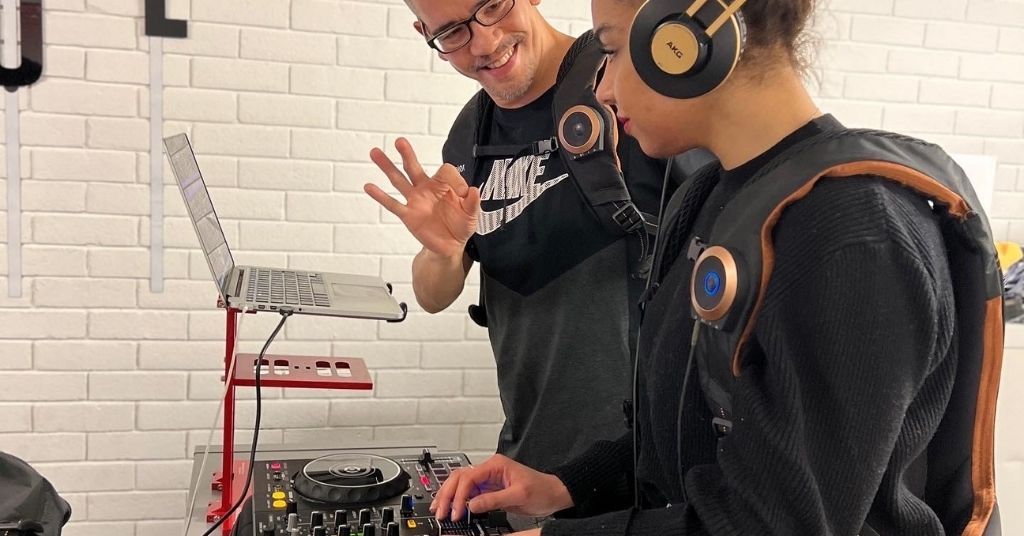
COVID-19 pandemic hits deaf college students hard
May 20, 2020
Tips for communicating with the deaf community when wearing a face mask
May 25, 2020Learning guitar with a hearing loss

When I was a child, I always dreamed of playing the guitar. As an adult, I am finally starting to live out my dream.
Learning guitar with a hearing loss hasn’t been easy, but it’s been worth it.
Picking up a guitar for the first time
I was eight years old the first time I picked up a guitar. It was an acoustic guitar that my grandparents kept in their basement from when my mom briefly learned guitar as a child. I was fascinated when I held it in my hands. I slung the strap over my shoulder and strummed all the strings. It was the most beautiful sound I’d ever heard because it was not a recording, it was real. I happily spent the rest of the day strumming all the strings and singing all the Faith Hill and Shania Twain songs I knew, even though I didn’t know any real chords or strumming patterns.
Read more: Can my child learn to play a musical instrument with their hearing loss?
Guitar Hero
It wasn’t until I was 13 that I picked up a “guitar” again, in the form of a Guitar Hero controller. To my great surprise, I loved the game and got past the “easy” and “medium” levels quickly. I liked playing “Sweet Child O Mine” by Guns and Roses at the “hard” level because the beginning of the song sounded so cool to me. My fingers would fly across the buttons in perfect time, so I could “play” the song via video game simulation.
Free Guitar Lessons
At 23 years old, I started my first job out of college. Browsing the internal company website, I discovered that someone at work offered free guitar lessons! I excitedly emailed him and told him I wanted to start learning, but my only prior experience with instruments was Guitar Hero and I didn’t have a real guitar. On our first day, he brought along an extra guitar for me to use and we started with tuning our guitars. He tuned his first with a tuner and then he showed me how to tune my guitar to his guitar.
“Listen,” he said, “you can hear if your guitar is in tune with mine if we both strum our strings at the same time and they sound the same.” We started with our low E string and I listened. I couldn’t tell what I was listening for, but they seemed similar enough.
“Too sharp,” he said.
What does that mean? It sounded fine to me! I adjusted the knob on the guitar and tried again.
“Still too sharp.”
Uh… I turned the knob any which way and hoped it would work this time.
“Perfect.”
Stuck on G
So I couldn’t hear the guitars in tune with each other. Maybe it was my untrained ear or maybe it was because I just perceive sounds differently with my hearing aids. I never quite figured out if our guitars were in tune with each other or not. We moved on to chords and I started with the “G” chord that is so often used in songs. I was waiting to find out that I’ve secretly been a guitar prodigy my whole life, if only I’d tried it sooner! Alas, G was hard. I was stuck on G for months. It seemed that my fingers just couldn’t comfortably hold down those strings.
“I was waiting to find out that I’ve secretly been a guitar prodigy my whole life, if only I’d tried it sooner!”
Several months later, with practice, I got the G chord down. I also started paying for lessons with a new guitar instructor. I was a bit nervous so I let him know ahead of time about my hearing loss, that I have no prior musical experience, and that I could only play G.
“What songs do you want to learn? I figured I’d ask so I don’t start with “Mary Had a Little Lamb” or something,” he said. I laughed and revealed that I actually wanted to learn “Free Bird” by Lynard Skynard, as crazy as that sounded. To my surprise, all he said was, “Okay. We can do that.” Then, he taught me the “F” bar chord, which is far worse than “G.”
Learning Guitar With a Hearing Loss
It’s been over a year of learning how to play guitar and though I have not mastered all of “Free Bird,” I have learned so much about playing guitar, reading music tabs, and the composition of songs. More than that though, I have learned to listen more deeply to songs. I can’t pick chords out of a song as easily as my instructor can, but I’m beginning to hear more of the details a guitar brings to songs.
I also transitioned from tuning my guitar “by ear”, to using a clip-on tuner, and finally to using an app on my phone. The app is super helpful to me because it uses my phone’s microphone to listen to the sound of each string, and it tells me when they are too “sharp” or too “flat” so I can adjust the strings accordingly. This takes all the guesswork out of tuning for me, and I still don’t always pick up on it when something sounds weird.
Sometimes when my instructor says, “Play that again, that doesn’t sound right,” my response is, “…it doesn’t?”
I’ve learned to accept that I may not hear the sounds the way other people do and I may need to do things a little differently, but it’s all music to my ears!



